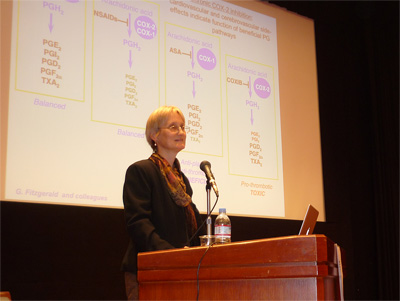The cyclooxygenases COX2 activity is induced in acute paradigms of excitotoxicity such as stroke and CNS trauma and also in chronic paradigms of inflammation, leading to synaptic loss and neurodegeneration, such as Alzheimer’s disease (AD), Parkinson’s disease and amyotrophic lateral sclerosis (ALS). COX-1 and COX-2 catalyze the first step from arachidonic acid in the formation of prostaglandins PGE2, PGD2, PGF2a, PGI2 and thromboxane A2 (TXA2).
PGE2 binds to four G-protein-coupled receptors, E-Prostanoid 1-4 (EP1-4). While EP1 function as toxic, EP2, EP3 and EP4 serve as neuroprotective.
With regards to AD, NSAIDs reported to protect against development of AD in normal aging population. PGE2 levels have been found to be increased before the onset of AD and EP2 receptor expression is also increased in AD.
Inflammatory oxidative stress is mediated by PGE2-EP2 receptor and deletion of the EP2 receptor in APPS mice (a model of familial AD) resulted in decreased amyloid -b (Ab) 40 and 42 peptide level, which is associated with oxidative damage. EP2 deletion in APPS mice also led to the decrease of BACE1 processing of amyloid precursor protein (APP) to b C-terminal fragment (b-CTF). EP2 was induced in microglia in APPS mice. EP2 mediated age-dependent increase in oxidative stress and increased Ab peptide via effects on BACE 1 activity.
In G93A SOD mice (a model of Familial ALS) with EP2 deletion, survival and motor strength were improved and the increase of pro-inflammatory gene was blocked.
In inflammatory paradigms, PGE2 and EP2 signaling induced pro-oxidative level.
However, in excitotoxic paradigms, many PG receptors rescued neurons from excitotoxicity in vivo. In the MCAO-RP (middle cerebral artery occlusion/reperfusion) model, the deletion of EP2 increased cerebral infarction.
Neuronal EP4 signaling is protective and EP4 receptor activation is cerebroprotective after cerebral ischemia. In MCAO-RP model, administration of EP4 agonist improved behavioral scores and reduced infarct size. Endogenous neuronal EP4 protects against cerebral ischemia. Conditional deletion of endothelial EP4 increased stroke injury and reduced cerebral perfusion in the MCAO-RP model. Furthermore, EP4 receptor is found to be protective in the model of perinatal brain hypoxia-ischemia.
Endothelial EP4 receptor regulates Akt-eNOS pathway in cerebral microvessels and EP4 receptor activation induced the increase of p-eNOS. Chronic inhibition of EP4 receptor is deleterious.
Anti-inflammatory response was lost in Cd11bCre:EP4-/- mice. In adult microglia, EP4 signaling increased inflammatory gene expression, for example iNOS, IL-6, TNFa and Gp91. EP4 increase resulted in decreased pAkt and pI-kB, and decreased nuclear translocation of NF-kB.
Taken together, PGE2-EP1-4 receptors have distinctive roles in the variety of neurological diseases. These findings may provide new strategies to treat patients with these disorders.
(Written by Yoshiko Iwatani)
